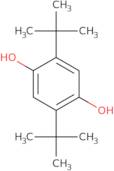
Produktinformation
- 1,4-Benzenediol, 2,5-bis(1,1-dimethylethyl)-
- 1,4-Dihydroxy-2,5-di-tert-butylbenzene
- 2,5-Bis(1,1-dimethylethyl)-1,4-benzenediol
- 2,5-Bis(2-Methyl-2-Propyl)-1,4-Benzenediol
- 2,5-Di-Tert-Butyl-1,4-Hydroquinone
- 2,5-Di-tert-butyl-1,4-benzenediol
- 2,5-Di-tert-butyl-1,4-benzohydroquinone
- 2,5-Di-tert-butyl-1,4-dihydroxybenzene
- 2,5-Di-tert-butylquinol
- 2,5-Dihydroxy-1,4-di-tert-butylbenzene
- Mehr Synonyme anzeigen
- 2,5-Ditert-butylbenzene-1,4-diol
- 3,6-Di-tert-butylhydroquinone
- Antage DBH
- Antioxidant Alba
- Antioxidant DBH
- Antioxidant NS 7
- BHQ
- Butylhydroquinone-Tert
- Dbhq
- Dibug
- Dibutylhydroquinone
- Dtbhq
- Hydroquinone, 2,5-di-tert-butyl-
- NSC 11
- NSC 9886
- Naugard 451
- Nocrac NS 7
- Nonflex Alba
- Santovar O
2,5-Di-tert-butylhydroquinone is a potent inhibitor of the two major phospholipases that regulate intracellular Ca2+ levels. It also inhibits epidermal growth factor (EGF) production in rat liver microsomes, and has been shown to inhibit the activity of cytosolic Ca2+/calmodulin-dependent protein kinase II (CAMKII), which regulates cell proliferation. 2,5-Di-tert-butylhydroquinone has also been shown to be a potent inducer of monoclonal antibody production in mice and is used as an adjuvant for the treatment of prostate cancer cells. This compound is metabolized by cytochrome P450 enzymes in liver cells and cardiac cells.
Chemische Eigenschaften
Technische Anfrage zu: 3D-FD41543 2,5-Di-tert-butylhydroquinone
Wenn Sie ein Angebot anfordern oder eine Bestellung aufgeben möchten, legen Sie stattdessen die gewünschten Produkte in Ihren Warenkorb und fordern Sie dann ein Angebot oder eine Bestellung an aus dem Warenkorb. Es ist schneller, billiger und Sie können von den verfügbaren Rabatten und anderen Vorteilen profitieren.





